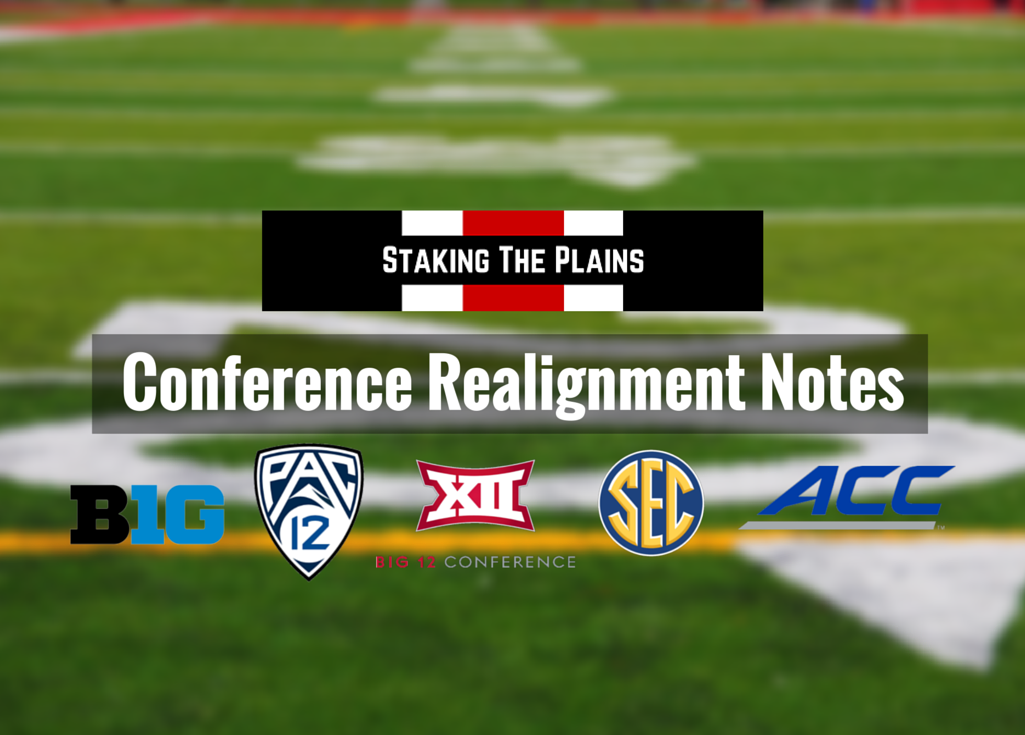Consolidation in 2026. FOX Sports’ Stewart Mandel writes that we have expansion all wrong, that by 2026, college football will consist of 24 teams, only the best teams, competing for a national championship.
To that end, the best possible way for an Ohio State or Alabama to maximize its value will be to shed the six or so games a year that only its own fans care about and turn every game into a national event. I’m talking one 24-team “conference” of only the biggest names in the sport, funneling exclusively into the College Football Playoff.
Call it the College Football Playoff Confederation.
Think Champions League in soccer, only these “clubs” won’t play another season. In fact, the Confederation may not even fall under traditional NCAA purview. UCLA could still compete as an NCAA member in the Pac-12 or Michigan in the Big Ten in all other sports, but for football, the biggest revenue-drivers would pool together into their own conglomerate.
Of course, I can’t winnow down the 65 current Power 5 schools to 24 without hurting some feelings. While many of the names are obvious (USC, Texas, etc.), others will surely elicit outrage from fans of schools excluded at their expense. But the overriding goal is to bring together the 24 most appealing programs from both a TV and competitive perspective.
A consolidation, not an expansion. The problem with this scenario is that I can’t see these individual colleges having this sort of power and really, somewhat dismisses what has traditionally been important and I think still is important, which is the rivalry between teams. SI’s Andy Staples does something similar in that he thinks a reduction of teams is what will happen, four 16-team super-conferences:
So, here’s my scheme. It is slightly different than the one I unveiled on my SiriusXM radio show Sunday night, as I would like to be a little more inclusive and realistic. My original plan involved 17 schools getting jettisoned from football’s top tier. The people who still feel beholden to bowl games that only drain from their bottom line likely wouldn’t do that to their cronies. So we’ll include almost every school currently in a Power 5 conference. This is a scheme that could work when the college sports landscape realigns again—especially if leagues want to sell their rights as one to set a premium price.
There would be four 16-team superconferences, and they wouldn’t leave the NCAA but would decide to have their football operations governed by a federation. The College Football Playoff is a consortium of leagues that runs the sport’s postseason; this would be a consortium of leagues that runs the entire sport for these schools. This federation would set its own rules, and if it wanted to head off any pesky federal lawsuits by collectively bargaining with players for an agreed-upon compensation plan, it could. All of the other sports would still be governed by NCAA rules. The federation would sell the first- and second-tier media rights for these 64 teams as a bloc. Like the NFL or the NBA, it could sell packages to different networks. By leaving the networks without the option of going to one of the other leagues that offers premium college football, this would raise the asking price even at a time when the rights-fee bubble may have popped. Would it inspire an antitrust suit from the schools left off the gravy train? Maybe. But that suit might also result in an NFL-USFL situation in which the dominant league loses the case and is ordered to pay $1 in damages. Third-tier rights would remain with the conferences, which could use them to program conference networks. Of these, only the ACC lacks one at the moment.
While the federation would feature four 16-team leagues, those conferences would not act in the way they do now. Their divisions would function independently for football purposes. Each would serve as its own conference, and the only required games would be between divisional opponents. Every team would play a full round-robin schedule within its division to decide a champion. Only division games would count toward a title, so teams could schedule their other five games—or four, because there may not need to be 12 regular-season games—as they wish as long as three of those games come against other schools in the federation. This last part would be to drive up the prices of the media rights deals. The networks want more killer than filler. The division champs would then face off in a conference title game. This, essentially, would be the first round of the playoff. The four conference champions would then face off in a bracket.
It All Started with Oklahoma. The Oklahoman’s Berry Tramel joined DMN’s Kevin Sherrington, Barry Morn and Evan Grant to discuss Big 12 expansion, and the next time that a Sooner fans rails against Texas for the Longhorn Network, 12 years ago, the Sooners didn’t want a Big 12 Network, along with Nebraska, Texas A&M and Texas, all voted against such an idea:
Sherrington: There’s nothing that Texas can do. They have to have the Big 12 — that’s clear. No one else is going to let them have their own network, first of all, and secondly, at one time I thought it was possible that Texas would want to go independent. I think they checked everything out and decided, we’re in no position to do that at this time and so that’s when they cobbled the Big 12 back together again and tried to make amends with everybody.
Tramel: “You can’t blame Texas. In fact, if you want to blame somebody you can blame Oklahoma. Because Kevin Weiberg, almost 12 years ago, tried to put a Big 12 network together and he needed nine votes and he only got eight. The four he didn’t get were the big boys — OU, Texas, A&M, Nebraska. A&M and Nebraska have since flown the coop and now Oklahoma is here wanting to change the dynamics. But the Sooners were the ones who said, hey, we want the freedom to do our own network. What those schools didn’t realize — OU, Nebraska and A&M — what they didn’t realize the marketing power of Texas, that ESPN would give them such a bonanza. So you don’t have anybody to blame but yourself if you’re Oklahoma. It’s a conundrum because Texas needs the Big 12. They don’t want the Big 12 to go anywhere. But what David Boren is threatening is there might not be a Big 12 if we don’t have a Big 12 network. And what Texas is saying is the reason we need the Big 12 is it allows us to have the Longhorn Network. So it’s a dilemma that I don’t know is solvable.”Horn: But doesn’t Texas need Oklahoma as well? Don’t they really need Oklahoma?
Tramel: “Well, I would say that Oklahoma needs Texas more than that. But they need each other because Texas is losing its rivals. They have three historic rivals and now Arkansas left 25 years ago and A&M left five years ago. At some point you’ll be the only person standing in the room. The Sooners are a little bit ahead of that game because they lost Nebraska, they haven’t lost Oklahoma State although if you go conference realignment you never know what could happen. So it’s just a big mess. And conference realignment, while it’s fun for us, it’s one of the best marketing tools for media in years — I can write something about conference realignment and get 10 times as much reaction from readers as anything else I write — it’s really been a big mess.”
Tramel thinks that the Big 12 has to convince Texas that the Big 12 must add in order to be viable, which he doesn’t think has happened yet, and then things go from there.
Bad Day for Conference Networks. Via Big 12 Fantatics, they mention that Verizon has dropped ESPN from a particular package and thinks that this means that with Disney stock dropping (although this maybe temporary considering the Star Wars inventory Disney has on deck) ESPN could move to an a la carte option for cable subscribers. I’m not ready to kick ESPN away, although it’s clear they are cutting costs, simply because ESPN essentially helped carried Disney for a long while. Granted, the cable industry is changing quickly, but Disney is going to be fine, despite ESPN’s losses and I tend to think that some of the cuts needed to happen. They were paying a lot of talent.









